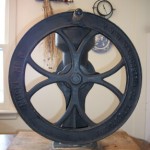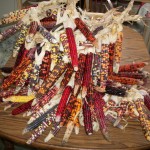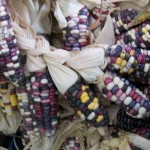Corn holds a kind of fascination for me. As a kid, we would filch ears of dent corn from the farmer’s fields in the summer when they were green and roast them. Roadside stands sold sweet corn at the end of every farmer’s driveway. Every farm kitchen had a corn mill, and cornmeal was a regular ingredient that had no need to be grown with pesticides or herbicides. The fields were full of ground cherries that grew under the plants and up to the frosts you could gather them up by the pocketfull.
Now sweet corn doesnt taste like anything more than corn flavored syrup. Stories about issues with groundwater contamination, genetic mutant weeds that are resistant to every chemical out there, and every kid developing ADD and diabetes eating foods derived from the GMO foods we are being told by one side are bad for us, and the other side tells us are just as good if not better than the old crops.
So I would just rather grow my own. So I did.
Last year I grew corn at every garden I have. In my own yard I grew a speckled flour corn given to me called Wamneheza, which as I understand is Sioux for corn. <shrug> beautiful cobs, very similar to several other regional speckled flours grown by the Ponkas, Mandans, and Hidatsas. At the Minnetonka garden I grew out Mandan Lavender flour corn, which was a small plant well loved by the local rodents. I managed to get a few thousand seeds from there, so enough to grow quite a bit somewhere else. Person who lives next door to that garden has huge rodent and bird feeders right next to the garden. Maybe grains are not the best thing to grow there, unless I put a DeCon feeder in the garden to deter those who think her feeders are not enough. I did Country Gentleman Sweet Corn there too. Lost cause. All eaten before the ears even plumped up, and the huge stalks blew down in a windstorm.
At the Ness farm I grew Painted Mountain. Beautiful corn, nice soft flour, highly productive. Deep dark colors for the most part. That is the corn on the header of the page at this moment.
Out at my parents (roundbarnfarm.com) I grew a ton of corns, and in good quantity as well. Bear Island Flint, Roy Callais Flint, Iroquois White Flour, Mandan White Flint, and Tom Thumb Popcorn were the largest grow-outs there.
Over all, I ended up with maybe 100 pounds of rare corn seeds, of various kinds. I have been experimenting over the last few years, but this was the first year where not only did I grow corn, but we have more than we will logically eat before the next year. Also have a good idea on what does well here.
What does best, I have found, is that which has been grown in the northern areas for hundreds of years. The plants are not 10-12′ tall. They are 3-6′ tall. If planted by May 1st, they are tasseling by the 4th of July, and dried down by August. You can eat them in the green stage like sweet corn, or let them dry down for flour or cornmeal. Popcorn is a fun and easy thing to grow. You can prevent excessive crossing by simply staggering your planting dates and knowing how long types take to grow to tassel. If only one type is tasseling at a time, there is no crossing. I start planting late april, and finish the last types by June 1st. All of it is done before the first frosts.
We make everything from hot cereal, to polenta, to cornbread, to simple popcorn. All of it tastes good, and none of it tastes the same. Going to stay away from most sweet corn though. The raccoons and deer like it too much, and the nutritional values are pretty low. The flour and flint corns though last forever, taste fine when eaten like sweet corn, and store dry in a bucket until you are ready to eat it.
And damn is it pretty.





You write well, Tom. I enjoyed the article about your corn. I was especially interested to note your opinion as to flour corns being more nutritious and versatile than sweet corn, and just as good. Those multi-colored varieties are beautiful, you are so right about that!
Regards,
Lorna
of cupcakes, one vegan, one not, Deb’s onion and mtasurd tart, and a slab version of her tomato and corn pie. I finished everything at 2am, and decided to leave the foil-wrapped pies in the switched off oven
It is the higher protein levels instead of simply high sugar/starch levels. The harder corns have much higher protein levels, some close to 15%, and the mixed ones like Bear Island Flint (often called a flinty flour) are supposed to actually be the best as far as animal feed too.
Tom
A very interesting read my friend. You might end up superbly reviving Bear Island Flint if you keep on like that!!!
cool site, rss following now and hope to see many similar posts soon.
There are certainly a lot of details like that to take into consideration. That is a great point to convey up. I provide the thoughts above as common inspiration but clearly there are questions like the one you carry up the place the most important thing might be working in honest good faith. I don?t know if greatest practices have emerged round things like that, but I am positive that your job is clearly identified as a good game. Each girls and boys really feel the affect of just a second�s pleasure, for the rest of their lives.
Hello,
I’m wondering where I can find Bear Island Flint seed for purchase? I’ve scoured the internet and nothing is coming up. Do you have a specific source for it? We’d love to grow it here – thanks!
Last commercial source I knew of it was http://www.skyfiregardenseeds.com/ however I do not see it in their listing this year. I know it is genetically a part of the Victor Kucyk 2175 I am growing and selecting out of, and I have a small quantity of it in my deep freeze that is some years old which I need to get planted to increase again. It is grown extensively on the White Earth rez in Northern MN, but I am not aware of any commercial sales of it by them. Maybe I will dig it out and get some of it in the ground this year, but with how my life is right now I am making no one any promises as to what I am going to get done until I am physically capable of doing everything without worry about being in a hospital again.
I would welcome any type of speckled corn you could offer me. Or, I would really love to have some gaspe flint corn. Do you have any corn seed I could have? I can trade you some ‘Holcombe Prolifice’ white dent corn I just grew this year and should be mature in 2 weeks or so. It had silked in mid august. I am from washington state so I don’t have a long growing season.
Well, where are you? Get to Minnesota ever? I have a little left, but I gifted most of it to the head of the Ponka tribe’s head of Agriculture. I have another, mostly flint with some flour, that shows blue speckled kernels. Mandan Rainbow Flint. Seeds are mostly white, but like I said, shows blue speckling. My interest in corns is short season stuff. I only have 1 that is over 90 days, and most are closer to 75. Long season is of little use for me since then it all crosses with the monsanto fields that surround my growing areas. Short season stuff tassels and is drying down by the time those corns are hip high.
Sorry, just saw you are in Washington State. I do plan on growing it out again next year, and Amos Hinton (Ponka Ag) says they got 400 pounds of select seed from what I gave them to grow out.